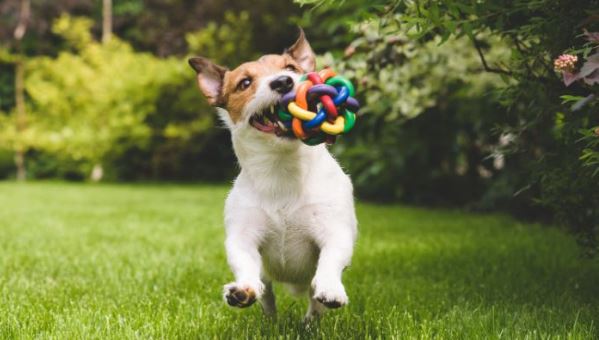For many dog owners, playtime isn’t just about a few minutes of tossing a ball; it’s a vital investment in their furry companion’s well-being.
Beyond the obvious tail wags and happy barks, research reveals that dog play is crucial for physical and mental health. It promotes exercise, reduces stress, strengthens the bond between dog and owner, and even helps prevent behavioral problems.
However, just like picking the wrong ingredients for a healthy meal, choosing the wrong toy can have unintended consequences, posing hidden dangers that go beyond simple frustration or boredom. Understanding these dangers and making informed choices based on research can ensure playtime is not only fun but also safe and beneficial for your canine friend.
Beyond Choking Hazards: A Spectrum of Dog Toy Risks
While choking hazards from small, easily chewed toys are a well-known concern, especially for puppies and small breeds, the dangers extend far beyond that. Studies by the American Society for the Prevention of Cruelty to Animals (ASPCA) highlight choking as a leading cause of toy-related injuries, but research also exposes other potential threats, including interactive feeding toys.
These toys, while beneficial for mental stimulation and slowing down fast eaters, can pose risks if not properly supervised or if they contain small parts that could break off and become choking hazards. It’s essential to carefully evaluate all toys for potential dangers before introducing them to your furry friend’s playtime routine.
- Toxic Temptations: Toys made with harmful materials or filled with toxic substances like stuffing can lead to poisoning if ingested. A study published in the Journal of Veterinary Emergency and Critical Care documented several cases of dogs suffering from lead poisoning due to ingesting toy components. Choosing well-made toys from reputable brands and supervising playtime are crucial steps in mitigating this risk.
- Dental Dilemmas: Hard, abrasive toys can wreak havoc on teeth, leading to chipped enamel, cracked teeth, and even tooth loss. A study published in the Veterinary Record found a significant association between hard chew toys and dental problems in dogs. Opting for softer, safer options like rubber or plush toys appropriate for your dog’s chewing intensity is key to protecting their pearly whites.
- Frustration’s Fiery Grip: Toys that are too difficult or inappropriate for a dog’s size and strength can lead to frustration and destructive behavior. Research published in Applied Animal Behavior Science suggests that providing dogs with appropriate toys can significantly reduce frustration and aggression. Matching the toy to your dog’s abilities and offering a variety of challenges keeps them engaged and prevents them from seeking their own (potentially destructive) entertainment.
Research-Backed Tips for Safe Toys
Fortunately, by making informed choices based on research and your dog’s individual needs, you can transform playtime into a safe and enriching experience for your furry friend. Here are some key points to remember:
- Size Matters: Consider your dog’s size and age when selecting toys. Bigger, sturdier options are ideal for larger dogs, while softer, safer choices are better suited for puppies or seniors.
- Know Your Dog’s Chew-sity: Opt for durable, long-lasting toys for aggressive chewers, while softer, plush options are perfect for gentler nibblers. Matching the toy’s material to your dog’s chewing intensity prevents them from ingesting dangerous fragments.
- Beyond Fetch: Not all dogs are created equal when it comes to play preferences. Some love to chase, while others prefer mental stimulation from puzzle toys or tug-of-war. Observe your dog’s play style and choose toys that cater to their interests.
- Variety is the Spice of Play: Just like humans, dogs get bored with the same old routine. Regularly rotate toys to keep things interesting and encourage engagement with new challenges.
- Safety First, Always: Even the most well-chosen toy requires supervision. Regularly inspect toys for damage and discard any that are worn, broken, or have loose parts to prevent potential hazards.
Interactive Feeding Toys: A Fun and Functional Option
In addition to traditional toys, interactive feeding toys can be a great way to combine playtime with mealtime, stimulating your dog’s mind and slowing down their eating. However, even with interactive feeders, some of the above safety considerations still apply:
- Choose the right size and difficulty: Ensure the toy is appropriate for your dog’s size and strength to prevent frustration or damage.
- Supervise mealtime: Monitor your dog’s interaction with the feeder to ensure they don’t ingest inappropriate parts or become overly frustrated.
- Clean regularly: Wash the feeder thoroughly after each use to prevent bacteria growth and maintain hygiene.
These toys often require problem-solving or manipulation to release kibble or treats, offering mental and physical engagement during feeding.
Conclusion
By understanding the potential dangers and making informed choices, you can turn playtime into a joyful and enriching experience that strengthens your bond with your dog while promoting their physical and mental well-being. So, the next time you reach for that squeaky toy or head out for a game of fetch, consider the environment in which you’ll be playing, the safety of the toys you’ll be using, and the specific needs and limitations of your furry friend. By prioritizing safety and mindfulness, you’ll create moments of pure joy and connection that both you and your dog will cherish for years to come.












